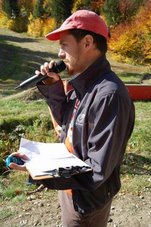This weekend I got talked into doing the 3/4 crit at RPI's Tour de Troy. I doubt RPI will ever put on that course again, way too much hostility from the city government, but if anybody does, I highly encourage doing it. Awesome course in a great downtown venue.
The 3/4 was basically a throwaway to let some of the locals race and collegiate guys to do more miles. It was super late in the day (5pm start) and cold (mid to low thirties), so only about a dozen people lined up. I only finished at the back of the lead group, completely unable to match Drexel Tim's breakaway in the closing laps, so nothing amazing to report. It was, however, super ridiculously fun, and the first time in years that I did a race and just plain had a good time. I was also super happy about it because my endurance is actually really high right now but I have not been doing much/any intensity, so I was pleased to hang on to some strong guys even without warming up.
I wanted though to point out three things from the race in hopes that they might be useful to newer racers:
Field Reading
I can't stress enough that being able to read the riders around you is, in my opinion, the most important skill to work on. I spend a lot of time with new racers and they all constantly say things like "I felt strong, but I just got dropped" or "I was riding the corners well, but I just got gapped in the last one." Lots of times, that's actually because the people around you aren't riding well. Especially in a very small group, you need to closely watch the two or three guys in front of you. If they look like they're cracking, you need to get around them so that you don't get caught behind a huge gap when they fall behind. Lately I've mostly tailgunned the back of the field on group rides and what few races I've been doing, and it would never work if I wasn't allocating the vast majority of my mental focus to watching out for this and coming around people as necessary.
Pick Your Battles
Everybody has strengths and weaknesses, and that extends to particular course features. This course, for example, was pretty non-technical, but had 6.5 corners in a kilometer course so they came up fairly quickly. The three middle ones in particular came in rapid left/right/left succession so it warranted some care. I was not able or willing to whip through them quite as fast as the leaders, but after a couple laps it was clear I had a better line on the two closing corners. That freed me from having to really worry about the middle three. I could mentally relax, and I didn't have to jump as hard coming out of them to cover that difference because I'd still be able to move up and be energy neutral for the lap after the next set.
Control the Field
After the first twenty minutes or so of the race, a few riders had dropped behind but everybody else was pretty much doing a nice, pleasant group ride of ~9 or so. Coming off a cold start---too much running around with a last minute crisis at registration---I had finally warmed up and was just hanging out in the back with my friend Maggie, definitely riding slightly above her comfort zone but hanging well with the boys. There weren't any primes planned for the race, but a few spectators offered up cash for some impromptu sprints. As soon as I saw the officials getting out the bell, I knew Maggie and I were screwed. She would almost definitely get dropped if the pace went much higher and I was worried about three things:
- Someone would get too jumpy and there'd be a crash.
- I'd get dropped and lose contact as the leaders ramped up the pace.
- The already tiny field would shatter and we'd all wind up doing boring ass solo TTs in significant wind for the next 20 minutes.
Knowing I would never be able to take the prime around the top guys, instead I focused on the bigger picture of those three concerns and immediately jumped to the front of the field. Most people probably figured it a pointless, stupid effort, attacking way, way too early. Instead though, I intentionally went to the front and tried to raise the pace just enough so that people would hesitate to come around and attack the group. Similarly, by pulling all the way into the sprint I gave a bunch of guys---who would have crushed me anyway---a good leadout, but ensured I was on their wheels coming out of the sprint.
In practice this worked beautifully. By going above my threshold but not spiking it, I protected my own minimal high-intensity energy reserves and made sure that:
- I was in front in case someone did crash, and helped prevent that by keeping it calmer.
- Made damn sure I was on the leaders' wheels coming out of the sprint in case they kept going and attacked off the prime.
- Discouraged anyone from attacking and either getting up the road or causing the group to shatter; in the event, Maggie and I both made it through totally fine and the group stayed together.
All of this was vindicated when another unexpected prime came up a few laps later. Unable to come forward and do the same thing, three things instantly happened:
- Some guy in the middle of the group overcooked a corner and crashed.
- Half the group got dropped and shattered into TTs.
- I barely made the lead selection, but couldn't come forward to match the winning counter attack that come shortly thereafter.
So, a tactic to think about. On the surface it's a stupid move if you're aiming to win, but there is a lot you can do to impose your will on a field if you're willing to put out a little extra effort, like protecting yourself and your "teammate" like I did here.



No comments:
Post a Comment